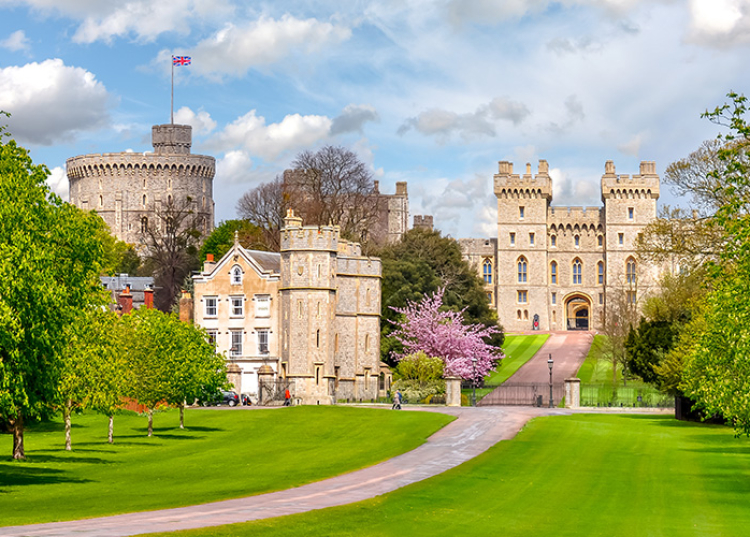After the troubled reigns of her uncles, Queen Victoria is often credited with re-establishing the reputation of the British monarchy. Along with the expansion of the enormous British Empire, Britain experienced a wave of great cultural, scientific, communicative, and industrial innovation.
Alongside her role as Queen, Victoria, her eight children, and husband Albert enjoyed spending time at a range of different stunning historical sites across Britain. These included the traditional – such as Westminster Abbey, which was the site of Victoria and Albert’s marriage – to the more unusual and private, such as the palatial Osborne House on the Isle of Wight, which was adored by the royal couple.
Here are 10 British sites which are most closely associated with Queen Victoria.

1. Kensington Palace
Kensington Palace in London has been the home of Britain’s young royals for over 300 years, including Queen Victoria, who was born and raised there, and is said to have hated it. Today, it provides a personal look into the lives of many of its past occupants including Victoria, Princess Diana, George I and II, William and Mary, and many others.
It remains the royal residence of the Duke and Duchess of Cambridge, alongside a number of other members of the royal family. It is also open to visitors under the remit of Historic Royal Palaces however, with 4 different routes available to explore its many intriguing rooms.

2. Buckingham Palace
Buckingham Palace has been the official residence of Britain’s monarchs since 1837, when Queen Victoria first occupied it. With 775 rooms, Buckingham Palace is a magnificently vast site and one of Britain’s most recognisable buildings.
Victoria expanded the Palace to accommodate her growing family, and before Prince Albert‘s death it was often the site of musical entertainments and lavish costume balls. Following the Prince’s death in 1861 however, Buckingham Palace remained shuttered and empty for many years, as Victoria could seldom stand to be in London.

3. Balmoral Castle
Having fallen in love with the Highlands after their first visit in 1842, it was Queen Victoria and Prince Albert who first bought the lease to Balmoral in 1848, despite having never visited the site itself. Thus that same year the pair ventured to their new estate, with Victoria writing in her diary that: “All seemed to breathe freedom and peace, and to make one forget the world and its sad turmoils”. The surrounding area reportedly reminded them of Thuringia, Albert’s German homeland.
Today Balmoral Castle remains the private residence of the British Royal family, and as such many of their private rooms are closed to the public. Between April and July however, some of Balmoral is open for visitors.

4. Westminster Abbey
The site on which Westminster Abbey was built was already of religious importance prior to its construction. The earliest record of the site of Westminster Abbey being used for religious purposes dates to the mid 10th century, when St Dunstan arrived at what was then known as Thorny Island to establish a religious house for the Benedictine order. The king built his church near to the existing monastic buildings.
In 1066, William the Conqueror added to the growing prestige of Westminster Abbey by choosing to be crowned there, becoming King William I on 25th December 1066. From that point onwards, Westminster Abbey would be the site of almost every royal coronation. It was there that Queen Victoria was crowned on 20 June 1837.

5. Osborne House
The Osborne estate was first bought by Victoria and Albert in 1845, following which they built the huge palatial mansion that is found today. Albert had a large hand in the building’s Italianate design, which was thereafter known as the ‘Osborne style’ and inspired the construction of similar buildings throughout the British Empire. Much of the gardens and the wider estate also owe their picturesque designs to Prince Albert, who took a keen interest in their composition.
Intended as a hideaway from the stresses of court life at Windsor, the couple spent as much time as possible at Osborne and their Scottish holiday home of Balmoral, spending most of their birthdays and special events there. When Albert died in 1861, the distraught Victoria found solace in Osborne’s peaceful surroundings and used it for the remaining 50 years of her life. There she continued to spend time with her vast family and entertain foreign dignitaries, including numerous kings and queens.

6. St James’s Palace
St James’s Palace has been the setting for some of the most important events in Royal history. It was also the official residence of Kings and Queens of England for over 300 years, from King Henry VIII up until the reign of Queen Victoria, when this role was taken over by Buckingham Palace.
Royal marriages such as William and Mary, George III and Queen Charlotte, Queen Victoria and Prince Albert, and George V and Queen Mary all took place there.

7. Windsor Castle
Windsor Castle is the oldest and largest occupied castle in the world – home to over 900 years of royal history. Covering an area of approximately 13 acres, it contains a wide range of interesting features.
Queen Victoria and Prince Albert loved Windsor castle, and Prince Albert died there of typhoid in 1861. Queen Victoria built a mausoleum in the grounds of the castle, Frogmore, where Albert and later Victoria herself were buried.


8. Albert Memorial
The Albert Memorial in Kensington Gardens is one of London’s most ornate monuments. It was commissioned by Queen Victoria to honour her husband, Prince Albert, after his death in 1861. Designed by George Gilbert Scott, the memorial stands near the southern boundary of the park, between Alexandra Gate and Queen’s Gate and was unveiled in 1872. The memorial was built from 1864-1876, after a national competition to select a design and cost a total of £120,000 which was raised by a combination of public subscription and Parliamentary grants.
Influenced by the series of 13th Century Eleanor Crosses such as Charing Cross and other statues in Edinburgh and Manchester, Scott’s memorial design is in the victorian gothic style. The centrepiece of the memorial is a 14-foot high statue of Prince Albert holding the catalogue of the Great Exhibition, held in Hyde Park in 1851, which he inspired and helped to organise.

9. Royal Albert Hall
Built in 1871, the Royal Albert Hall has been one of London’s most popular entertainment venues for nearly 150 years. The Grade I listed building survived two world wars, looking almost the same today as it did during Queen Victoria’s reign. Originally called the Central Hall, this building project was started by Prince Albert using the profits of the Great Exhibition of 1851, which took place in Hyde Park, just opposite the site.
Queen Victoria chose to rename the building the Royal Albert Hall of Arts and Sciences, and HRH The Prince of Wales declared the Hall officially open on 29 March 1871, on behalf of his mother. Queen Victoria was present but was too overcome with emotion to speak – reminded of her late husband, Prince Albert, who had died a decade earlier. Albert never lived to see the Hall named in his honour.

10. Crystal Palace Park
Crystal Palace Park is am 80 hectare Grade II* listed Victorian pleasure grounds located in the south London suburb of Crystal Palace. It surrounds the site of the former Crystal Palace Exhibition building. The Crystal Palace and Park were built between 1852 and 1855. It was designed to be a magnificent accompaniment to the relocated Crystal Palace, which had previously been located in Hyde Park for the Great Exhibition of 1851.
Victoria’s husband Albert was one of the driving forces behind the creation of the Great Exhibition. They stated that they intended it to be for all nations, the greatest collection of art in industry, ‘for the purpose of exhibition of competition and encouragement’.


